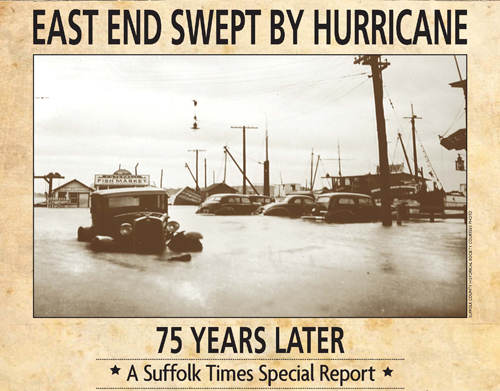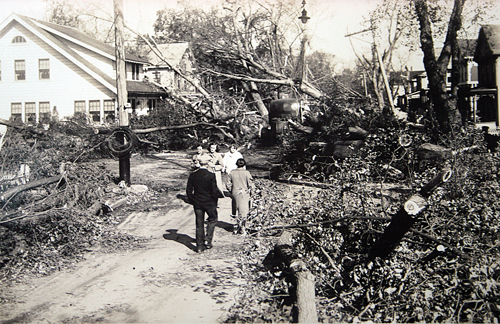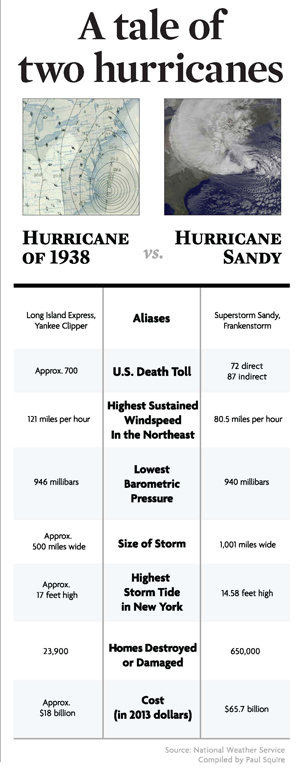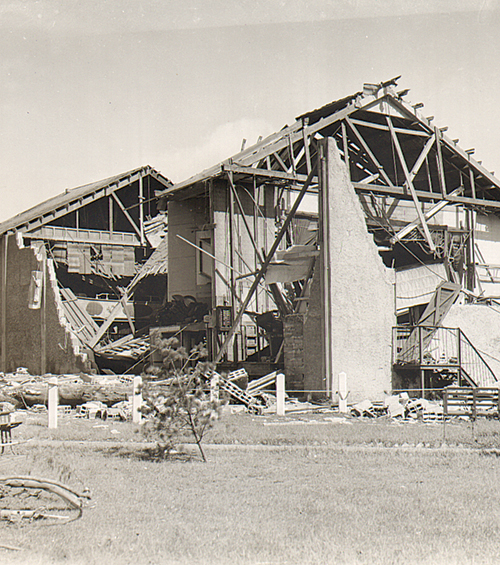Remembering the ‘L.I. Express’ hurricane of 1938

Sept. 21, 1938, was shaping up to be just another gray day on the North Fork.
Despite the clouds, Greenport brothers Arthur and Jack Levin weren’t fazed by reports of a hurricane speeding up the East Coast. After all, it had missed the southern states and weather predictions showed the storm was headed out to sea.
That morning’s New York Times editorial only boosted their confidence. The editorial hailed the U.S. Weather Bureau’s “unparalleled warning system” for alerting the public to inclement weather. The Times’ opinion piece focused on the hurricane that was expected to slam Florida, but turned eastward, avoiding landfall.
That same day, the bureau’s advisory out of Washington, D.C., made no reference to the same hurricane, which even the most seasoned meteorologists assumed was destined to fizzle out in the Atlantic.
But by mid-afternoon that Wednesday, the wind had begun to pick up in Southold Town. The brothers sensed something was coming.
Hurricane outlook: When will the next big storm hit?
Arthur Levin, then 17, boarded up the windows at this father’s prominent men’s store on Front Street in the village, one of the only stores to do so. Across town, Jack Levin also decided it was time to close up at the Shack — the snack bar at Southold Town beach that he managed. Business was slow that day, anyway.
“I wasn’t in a hurry,” Jack, now 104 years old, told The Suffolk Times last week. “The wind just picked up and water got rough … I wasn’t scared.”
Jack headed back to the family’s home on West Street in Greenport.
Video: Relive the Hurricane of ’38
Around the same time, the whipping breeze had grown into blustering gusts. Arthur stacked sandbags outside his father’s shop before locking himself inside to wait out whatever was about to hit.
“I was a scared 17-year-old that never experienced anything like that before,” Arthur, now 98, recalled.
A half-hour later, the hurricane that would become known as the “Long Island Express” unleashed its fury on the East End.

•
 Now, 75 years from that September day, the storm known officially as the New England Hurricane of 1938 has gone down in the record books as one of the most powerful and costliest ever to hit the region.
Now, 75 years from that September day, the storm known officially as the New England Hurricane of 1938 has gone down in the record books as one of the most powerful and costliest ever to hit the region.
It slammed into the Northeast as a Category 3 hurricane, with wind speeds gusting to more than 120 mph, toppling nearly two billion trees, according to National Weather Service estimates. A wall of water estimated at 15 feet crashed over Long Island. The storm made landfall on the South Shore sometime between 2:10 and 2:45 p.m. As quickly as the storm struck, it was gone, barreling across Long Island Sound into Connecticut, Rhode Island and Massachusetts within hours.
As many as 700 people were killed.
Related: Business owners still picking up pieces after Sandy
“Homes were washed away, roads were washed away, Long Island Rail Road tracks were washed out, any of the fishing industry out here was gone, the apple crop was destroyed, a lot of livestock and farming was destroyed,” National Weather Service meteorologist David Stark said in a recent interview. “This was a very powerful, very destructive storm no matter how you look at it.”
Speed was partly to blame for the devastation, Mr. Stark said.
The hurricane traveled as fast as 60 mph up the coast — faster than any other storm in recorded history — after it got caught in the jet stream.
Without modern-day technology like satellites and radar, Long Island was caught off guard.
“Back then we were relying on data from ships going across the Atlantic,” Mr. Stark said. “They were thinking it was a tropical storm at that point. They didn’t really see [its] actual strength.”
Related: How to prepare for the next big storm
Westhampton Beach bore the brunt of the hurricane’s force. The village area was flooded under eight feet of water. A movie theater filled with customers enjoying a matinee reportedly was lifted off its foundation by the storm’s waves and carried two miles out to sea, where it sank – drowning all inside.
The North Fork wasn’t spared either.
Storm surges of nearly 12 feet swept across Southold Town and power lines were torn down by the wind and caught fire, Mr. Stark said.
Fifty residents were also gathered inside the Greenport movie theater that afternoon, according to an article in that week’s Suffolk Times. As the hurricane intensified, the patrons crowded into the lobby to wait out the storm. But the theater — like its South Shore counterpart — began to collapse and those inside scrambled across the street for cover as the building’s back wall caved in.
No one was seriously injured, the article states.
A constable waded through waist-deep water during the height of the storm to rescue two women trapped in a bungalow, according to the article, while parts of the village’s concrete sidewalks were “standing on end.”
The shipyards in Greenport were “demolished,” fishing vessels and personal boats were sunk and East Marion and Orient “presented a sight of utter destruction,” with the steeples of Orient’s Methodist and Congregational churches knocked off, the article states.
In Southold, a 41-year-old man was thrown from his roof and killed as he tried to make repairs during the storm, and most of the town’s trees were uprooted, the Suffolk Times reported. A young Southold woman was trapped on her yacht during the hurricane and swam nearly a mile to reach the safety of the shore.
A tree crashed through the roof of The Suffolk Times office and the paper was delayed for three days while crews worked to restore power to the printing press.
“We have gone into considerable detail to give you as good an account of the storm as possible,” the newspaper’s publisher, F. Langton Corwin, wrote to readers in the paper’s truncated four-page issue. “We could fill column after column with stories of heroism on the North Fork and descriptions of thousands and thousands of dollars of property damage.”
A private study done by a risk management company in 2008 showed the storm brought unparalleled destruction to the East End. The damage was equivalent to an F3 tornado, according to the study.
The storm caused $620 million in damage at the time, Mr. Stark said, or roughly $18 billion today. He added that if the 1938 hurricane hit today, it would cause an estimated $41 billion in damage.

•
Greenport was completely “demolished” by the storm, the Levin brothers recalled.
“When the hurricane stopped we walked around and every other tree was down,” Arthur said.
Boats were lying in the middle of the roadways and Claudio’s Restaurant was overtaken by sea water.
When Jack returned to the Shack the next day, he found it had floated clear across Route 48.
“I’ve never seen anything like it,” he said.
Orient resident Ed Latham recalled unprecedented devastation. “Everything was in shambles,” he said.
Then 15, he was attending class at Greenport High School and had no idea a major storm had even struck.
“No one said anything and that school is so solid you’d never know,” he said.
Mr. Latham, now 91, said the first time he laid eyes on the damage was when his father picked him and a friend up from school. The three walked seven miles back to the Latham family farm in Orient, encountering downed trees, wires and floodwaters along the way.
“We went to school that morning on the bus and after lunch the roads were impassable,” he said. “We had to crawl on our bellies to get under the trees in some places.”
Mr. Latham said the storm tore down all the trees on his family’s property and that saltwater devastated crops for the next two years.
But there was a silver lining to the Long Island Express, Arthur Levin said.
“After that, Greenport became prosperous,” he said. “There was a lot of work for people. They had to saw down the trees, repair homes, so there was a lot to do.”
•
Ten times more people were killed by the Long Island Express than by Sandy.
Sandy brought winds near 80 mph, but Mr. Stark said those winds stayed below hurricane force across most of Long Island.
The storm of 1938, by comparison, had sustained winds of 20 to 30 mph stronger than Sandy’s most powerful gust.
And Sandy’s historic surge, which swamped downtown Greenport, was still at least three feet lower than the tide brought in by the 1938 hurricane.
Meteorologist Stephanie Dunten at the National Weather Service station in Taunton, Mass., said that while other storms may share similar wind speed, storm surge or pressure readings, no other hurricane in the region’s recorded history has combined the different elements to create such a powerful storm.
“All the different storms have bits and pieces of it, but this one has everything,” she said. “It just baffles me.”
Weather experts say the historic nature of the 1938 hurricane’s power means few storms can match the destruction of the Long Island Express.
But storms like Sandy prove that the threat — however small — of a powerful hurricane always looms.



